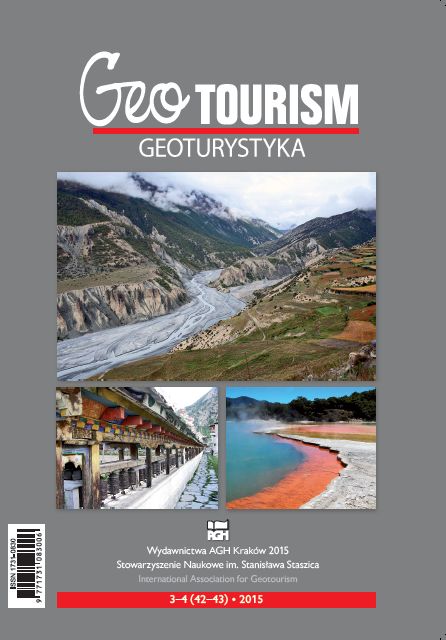The use of the Butler Cycle and the Chaos Theory in the interpretation of the development of the Żegiestów-Zdrój health resort // Zastosowanie cyklu Butlera i teorii chaosu w interpretacji rozwoju uzdrowiska Żegiestów-Zdrój
DOI:
https://doi.org/10.7494/geotour.2015.42-43.67Keywords:
health resort, TALC, chaos theory, Żegiestów-Zdrój // uzdrowisko, teoria chaosu, Żegiestów- -ZdrójAbstract
In the article, the natural conditions and natural therapy facilities of Żegiestów-Zdrój – a small health resort in the Carpathian mountain range, have been described. In the course of the analysis of the development of this resort, R.W. Butler’s model of tourism area life cycle (TALC), was applied. The analysis has revealed that that the life cycle of Żegiestów-Zdrój has no predictable, linear form, and its course is extremely difficult to foresee, as is proved by the intermittent and unstable development line. The development of the health resort is better illustrated by the chaos theory which adopts the shape of a non-linear course of events. Supplementing the analysis of the life cycle with chaos theory has allowed the author to describe the course of development of Żegiestów-Zdrój in a much more precise way. In the summing up, the chances for a renaissance of the heath resort and an initiation of a new cycle of its development have been presented. The above theories may be applied the process of interpreting and forecasting changes in other health resorts. //
W artykule opisano warunki naturalne i zasoby przyrodolecznicze Żegiestowa – niewielkiego uzdrowiska karpackiego. W analizie rozwoju tego kurortu zastosowano model cyklu życia obszaru turystycznego R.W. Butlera (ang. tourism area life cycle – TALC). Analiza wykazała, że cykl życia Żegiestowa-Zdroju nie
ma przewidywalnej, liniowej postaci, a jego przebieg jest niezwykle trudny do odgadnięcia, czego wyrazem jest nieciągły i niestabilny przebieg zmian. Uzupełnienie analizy cyklu życia kurortu teorią chaosu pozwoliło na lepsze opisanie przebiegu rozwoju Żegiestowa-Zdroju. W podsumowaniu przedstawiono szanse na odrodzenia kurortu i rozpoczęcie nowego cyklu jego rozwoju. Opisane teorie mogą być wykorzystane w interpretacji i prognozowaniu zmian w innych uzdrowiskach.
Downloads
References
Berry T. 2011. The predictive potential of the TALC model. In: Butler R. (ed.), The tourism area life cycle: Conceptual and theoretical issues. Channel View Publications, Bristol, UK: 254–279.
Bertalanffy von L., 1984. Ogólna teoria systemów. Podstawy, rozwój, zastosowania, PWN, Warszawa.
Buhalis D., 2000. Marketing the Competitive Destination of the Future. Tourism Management, 21: 97−116.
Butler R.W., 1980. The concept of tourism area cycle of evolution: Implications for management of resources. Canadian Geographer, 24 (1): 5−16.
Dietl J., 1858. Uwagi nad zdrojowiskami krajowymi ze względu na ich skuteczność, zastosowanie i urządzenie, część I. Kraków.
Hess M., 1965. Piętra klimatyczne w polskich Karpatach Zachodnich. Zeszyty Naukowe UJ, Prace Geograficzne 11: 1−258.
Hovinen G.R., 2002. Revisiting the destination lifecycle model. Annals of Tourism Research, 29 (1): 209–230.
Jackowski A., Warszyńska J., 1979. Funkcja uzdrowiskowa i turystyczna regionu muszyńskiego. Zeszyty Naukowe UJ, Prace Historyczne, II: 149–193.
Kapczyński A., Szromek A.R., 2008. Hypotheses concerning the development of Polish spas in the years 1949–2006. Tourism Management, 29: 1035−1037.
Kowalczyk A., Derek M., 2010. Zagospodarowanie turystyczne. PWN, Warszawa.
Kruczek Z., 2010. Wykorzystanie cyklu Butlera do interpretacji rozwoju uzdrowisk na przykładzie Żegiestowa-Zdroju. In: Szromek A.S. (ed.), Uzdrowiska i ich znaczenie w gospodarce turystycznej, Monografia 5. Proksenia, Kraków: 41−53.
Kruczek Z., Weseli A., 1987. Uzdrowiska karpackie. Krajowa Agencja Wydawnicza, Kraków.
Kruczek Z., Szromek A., 2015. Wykorzystanie modelu R.W. Butlera w interpretacji rozwoju atrakcji turystycznej na przykładzie Kopalni Soli w Wieliczce. Folia Turistica, 25(2): 274−290.
Lundtorp S., Wanhill S., 2001. The resort lifecycle theory. Annals of Tourism Research, 29(4), 947–964.
Lundtrop S., Wanhill S., 2006. Time Path Analysis and TALC Stage Demarcation. In: Butler R.W. (ed.), The tourism area life cycle, Vol. 2 Conceptual and theoretical issues. Chanel View Publications, Clevedon, Buffalo, Toronto: 138−149.
Mazurkiewicz L., 2011. O próbie zastosowania teorii chaosu do opisu ewolucji obszaru. Przegląd Geograficzny, 83(2): 187−203.
Mc Kercher B., 1999. A chaos approach to tourism. Tourism Management, 20(4): 425–434.
Nurek T., 1979. Klimat i bioklimat Żegiestowa-Zdroju, Problemy Uzdrowiskowe, 11(145): 59−150.
Oppermann M., 1998. What is new with the resort cycle. Tourism Management, 19(1): 169–180.
Osóbka P., 2003. Żegiestów-Zdrój. Perła doliny Popradu. Sądecka Oficyna Wydawnicza, Warszawa.
Prigogine L., Stengers R., 1985. Order out of Chaos. Man’s New Dialogue with Nature. Flamingo, London.
Russell R., Faulkner B., 1999. Movers and shakers: Chaos makers in tourism development. Tourism Management, 20(4): 411−423.
Russel R., 2011. The contribution of entrepreneurship theory to the TALC model. In: Butler R. (ed.), The tourism area life cycle, Vol. 2 Conceptual and theoretical issues. Channel View, Clevedon: 105−223.
Shaw G., Williams A.M., 1998. Critical issues in tourism: a geographical perspective. Blackwell Publishers, Oxford – Cambridge MA.
Szromek A.R., 2010. Cykliczność rozwoju uzdrowisk na przykładzie uzdrowisk polskich. In: Szromek A.R. (ed.), Uzdrowiska i ich znaczenie w gospodarce turystycznej. Proksenia, Kraków: 17−40.
Zajadacz A., Śniadek J., 2011. Cykl życia obszaru turystycznego – studium przypadku regionu leszczyńskiego. In: Rapacz A. (ed.), Gospodarka turystyczna w regionie. Uniwersytet Ekonomiczny, Wrocław: 1029−1041.
Żegiestów-Zdrój wczoraj i dziś, 2010. Towarzystwo Przyjaciół Żegiestowa, Żegiestów.
Downloads
Published
Issue
Section
License

The content of the journal is freely available according to the Creative Commons License Attribution 4.0 International (CC BY 4.0).


